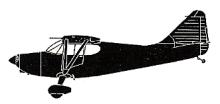
ASN Wikibase Occurrence # 289889
This information is added by users of ASN. Neither ASN nor the Flight Safety Foundation are responsible for the completeness or correctness of this information.
If you feel this information is incomplete or incorrect, you can submit corrected information.
| Date: | Wednesday 17 July 2013 |
| Time: | 14:50 LT |
| Type: |  Stinson 108-1 |
| Owner/operator: | Private |
| Registration: | N8721K |
| MSN: | 108-1721 |
| Total airframe hrs: | 1523 hours |
| Engine model: | Franklin 6A4150 SERIES |
| Fatalities: | Fatalities: 0 / Occupants: 2 |
| Aircraft damage: | Substantial |
| Category: | Accident |
| Location: | Tuftonboro, New Hampshire -
 United States of America United States of America
|
| Phase: | Standing |
| Nature: | Private |
| Departure airport: | Moultonboro, NH (5M3) |
| Wolfeboro, NH (NH31) | |
| Investigating agency: | NTSB |
| Confidence Rating: |
About 7 minutes after takeoff and while leveling off the airplane at 1,800 ft, the pilot leaned the fuel-to-air mixture, and the engine immediately began to run roughly. The more experienced right-seat pilot took control of the airplane and attempted to restore power, but his attempts were unsuccessful. The propeller continued to rotate briefly but then stopped. The pilot maneuvered the airplane for a forced landing in a field, and the airplane subsequently impacted a raised concrete culvert.
Postaccident examination of the engine revealed that the crankshaft was fractured. Metallurgical examination of the crankshaft revealed evidence of fatigue cracking that had originated from circumferential gouges at the aft radius of the R2 rod journal. A review of engine records revealed that, about 45 years before the accident, the crankshaft was replaced during an engine overhaul and that the main and connecting rod bearing journals were ground 0.010-inch undersize. About 7 years before the accident, the engine was overhauled again, and the crankshaft main and connecting rod bearing journals were polished. The engine was installed in the accident airplane about 3 years before the accident; the engine failure occurred about 115 hours after the engine's last overhaul. It is likely that, if maintenance personnel had detected and removed the circumferential gouges at the aft radius of the R2 rod journal during the engine's last overhaul, the fatigue cracking would not have started and the crankshaft would not have failed.
Probable Cause: Maintenance personnel's failure to remove circumferential gouges in the aft radius of the R2 rod journal on the crankshaft during its last engine overhaul, which resulted in the fatigue failure of the crankshaft and a subsequent total loss of engine power.
Accident investigation:
 |
|
Sources:
NTSB ERA13LA327
Location
Revision history:
| Date/time | Contributor | Updates |
|---|---|---|
| 05-Oct-2022 19:24 | ASN Update Bot | Added |
Corrections or additions? ... Edit this accident description
The Aviation Safety Network is an exclusive service provided by:


 ©2024 Flight Safety Foundation
©2024 Flight Safety Foundation